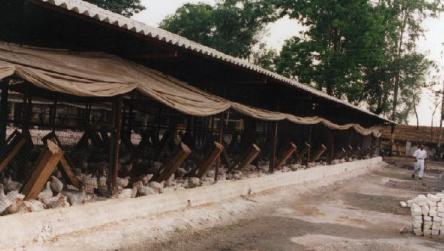Affordable alternatives in poultry housing

Cheaper yet effective poultry house construction deserves growing attention, particularly at a time as now when the global prices of wood, wire and brick are rising. Alternatives of such materials are available, but proper management is essential to ensure that bird health problems are avoided and that the overall performance of the flock is maintained.
By Dr Ross G. Cooper, Physiology Division, Birmingham City University, UK
One would find many publications specialising in affordable housing and the construction of simple poultry houses. There are some factors, however, that one needs to bare in mind. For example, bacterial infection is a serious problem. Vertical ventilation shafts can encourage vectors like flies to gain access to houses and limit cleaning efficiency. Boot dipping and provision of clean drinking water are therefore vital. In hot climates the use of Hessian-covered windows is adequate to prevent flies from entering the house, and the fresh air blows away ammonia from accumulated droppings. Diseases can also be controlled by providing suitable containers for feed, ensuring clean circulated drinking water, and the construction of efficient drainage systems.
Dry litter essential
Padded dowel flooring is a good option in producing cage broilers of about 2 kg in weight without leg or breast damage. The necessity of dry litter, whether provided as wood chippings, sawdust or straw, is essential to prevent infections, such as footpad dermatitis in young turkeys. Sometimes wheat straw cakes with excreta and wood shavings are preferred. Avian reoviruses survive the longest (up to 10 days) on feathers, wood shavings and chicken feed, and for the shortest periods on wood (2 days), paper and cotton (4 days). Reoviruses survive up to 10 days on eggshells in the presence of organic matter, and for up to 10 weeks in drinking water. Tea leaves may be used successfully as an alternative litter material for broilers, and higher nitrogen content would make it a better organic fertiliser, and possibly a ruminant feed. Hazelnut husks alone and when mixed with rice hulls are also a potential alternative litter material for broilers. Although peanut hulls perform similarly to pine shavings, the latter should be used with caution in case of aflatoxin contamination.
Comfort behaviour
Leaves are a very cheap and abundant source of litter material, and may be used alone or in combination with wood shavings. Nitrogen emissions are greater in broilers reared in the summer than in the winter period. A reduced frequency of scratching and ground pecking, as well as a higher percentage of comfort behaviour, was found in broilers kept on straw due to increased amounts of faeces and compression of litter material. Hens prefer peat and artificial turf to coated wire mesh for egg laying. Additionally, higher body weights are observed for turkeys housed on wood shavings compared with those on peat litter after 12 weeks of age.
Broilers reared on the floor may inhale litter dust and noxious fumes. This can result in impaired pulmonary gas exchange and increased levels of carbon dioxide. This, however, is not such a problem in broilers reared in clean stainless steel cages. Adjustment of relative humidity of the air in a broiler house to 75% will reduce inhaled dust but not respirable dust, the latter of which can be slightly reduced with fogging of pure water or water/rapeseed oil.
In Africa, wood beams cut from saplings and surrounding bush materials can be used cheaply to construct poultry houses and runs. Thatch – a cheaper option for roofing than polythene or corrugated iron sheeting – can be derived from cut grass, although it needs to be replaced on a regular basis, usually once a year.
Environmental effects
Disinfection protocols need to take understanding of environmental effects and affordability. For Salmonella infections the following solutions may be used in decreasing effectiveness: formaldehyde, glutaraldehyde/benzalkonium chloride, peroxygen compound, and WHO hard water. Disinfectant solutions containing cresylic acid are the most effective for eliminating mould. Simple pan traps placed in open areas are satisfactory for catching litter beetles and their larvae.
World Poultry Vol. 25 No. 2, 2009













